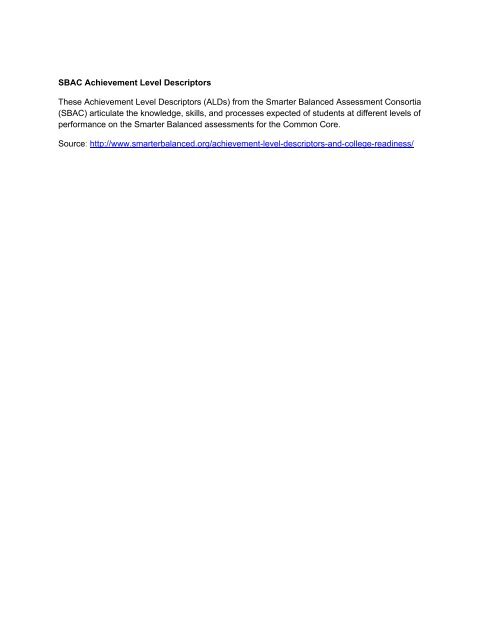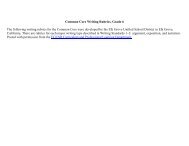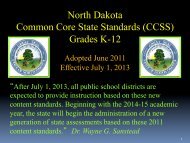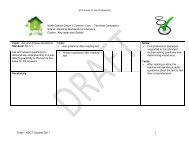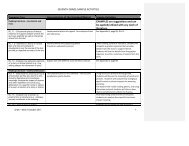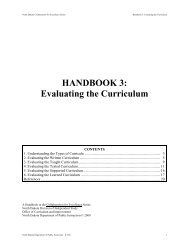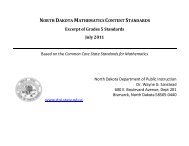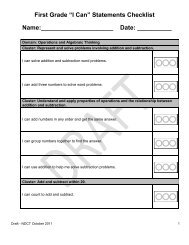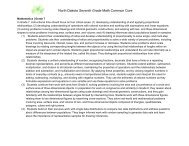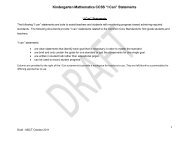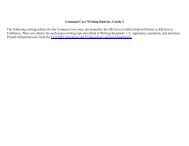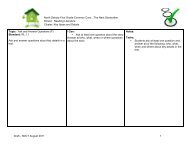SBAC Achievement Level Descriptors, Grade 4 - ND Curriculum ...
SBAC Achievement Level Descriptors, Grade 4 - ND Curriculum ...
SBAC Achievement Level Descriptors, Grade 4 - ND Curriculum ...
Create successful ePaper yourself
Turn your PDF publications into a flip-book with our unique Google optimized e-Paper software.
This document provides an overview of the ALDs including their use and purpose, summarizes theprocess used to create the ALDs, describes the designation of college and career readiness for<strong>Grade</strong> 11 students, and provides the proposed ALDs. Readers are encouraged to provide SmarterBalanced with feedback on this document.What Are <strong>Achievement</strong> <strong>Level</strong> <strong>Descriptors</strong>?<strong>Achievement</strong> level descriptors are a means of describing performance on a standardized test interms of levels or categories of performance. For the Smarter Balanced assessments, outcomes willbe reported in terms of four levels of achievement: <strong>Level</strong> 1, <strong>Level</strong> 2, <strong>Level</strong> 3, and <strong>Level</strong> 4. The ALDsare text descriptions of the KSPs demonstrated by students in each category of performance.Figure 1 (below) shows the relationship between performance on a standardized assessment andthe ALDs.Figure 1. Relationship between Test Performance and ALDsThe <strong>Level</strong> 1 ALDdescribes theKSPs of <strong>Level</strong> 1students.The <strong>Level</strong> 2 ALDdescribes theKSPs of <strong>Level</strong> 2students.The <strong>Level</strong> 3 ALDdescribes theKSPs of <strong>Level</strong> 3students.The <strong>Level</strong> 4 ALDdescribes theKSPs of <strong>Level</strong> 4students.Low Score on TestHigh Score on TestThe most commonly understood use of ALDs is to communicate the meaning of test scores. Whenreporting scores using ALDs, parents, teachers, and other stakeholders are provided summaries ofthe different levels of performance in terms that can be readily understood. It is important torecognize, however, that there are other purposes for ALDs beyond their use with score reporting,including guidance for policy and standard setting (establishment of “cut scores”), as well as itemdevelopment. To address the entire set of purposes, Smarter Balanced has developed a system ofinterrelated ALDs that support the entire testing program. This system includes four types of ALDs,which are defined below and summarized in Table 1.• Policy ALDs are general descriptors that articulate the goals and rigor for the final performancestandards. Policy descriptors set the tone for and are embedded within subsequent descriptors.These ALDS are very high-level and are most often used by policymakers.• Range ALDs are grade- and content-specific descriptors that may be used by test developers toguide item writing. Range ALDs describe the cognitive and content rigor that is encompassedwithin particular achievement levels.• Threshold ALDs are created in conjunction with or following Range ALDs and are used to guidestandard setting. Threshold ALDs are a subset of Range ALDs and use only the information fromRange ALDs that defines the minimum performance required to be considered as meeting theachievement level expectation.• Reporting ALDs are the final ALDs and are developed following standard setting. They provideguidance to stakeholders for interpreting student performance on the test. These ALDs will bedeveloped after the standard setting in summer of 2014.2
Table 1. ALDs by Use, Purpose, and Intended AudienceALD Type Use Purpose Intended AudiencePolicyTest development andconceptualizationSet tone for the rigor of performancestandards expected by sponsoringagencyPolicymakersRange Item-writing guidance Define content range and limits Item writers and testdevelopersThresholdCut-score recommendationand standard-setting guidanceDefine threshold performance ateach achievement levelStandard-settingpanelistsReporting Test-score interpretation Describe the KSPs that test takersdemonstrate and indicate theknowledge and skills that must bedeveloped to attain the next level ofachievementStakeholders, suchas parents, students,teachers, K-12leaders, and highereducation officialsThe policy, range, and threshold ALDs provided with this report are labeled as “initial” because theywill be refined and finally adopted by Smarter Balanced after student performance data are collectedthrough a national field test and after standard setting occurs. This will ensure a seamlessintegration of the ALDs with student performance measures.Developing <strong>Achievement</strong> <strong>Level</strong> <strong>Descriptors</strong> for Smarter BalancedSmarter Balanced held an ALD-writing workshop at the beginning of October 2012 to draft its initialPolicy, Range, and Threshold ALDs. K-12 and higher education representatives from each GoverningState participated in the workshop. The workshop panelists included K-12 teachers andadministrators, as well as faculty from two- and four-year colleges and universities. Individuals whohad strong knowledge of the CCSS and/or had participated previously in developing achievementlevel descriptors or learning outcome statements were nominated by their states’ K-12 and HigherEducation Leads (the primary state representatives to Smarter Balanced) and were selected bySmarter Balanced staff, volunteer leaders, and contractors. Members of the Smarter BalancedTechnical Advisory Committee and individuals from Student <strong>Achievement</strong> Partners who were primarywriters of the CCSS attended the workshop to act as expert advisors.To create the ALDs, the workshop panelists examined both the Smarter Balanced ContentSpecifications (www.smarterbalanced.org/smarter-balanced-assessments/) and the Common CoreState Standards (www.corestandards.org). For the Policy ALDs, the panelists delineated the SmarterBalanced overall claims and specific content claims described in the Content Specifications intoachievement levels. The Range and Threshold ALDs drew upon the assessment targets in theSmarter Balanced Content Specifications, as well as the specific content standards in the CCSS thatunderlie the assessment targets.3
Policy ALDsFor both ELA/literacy and mathematics, Smarter Balanced has an overall claim for <strong>Grade</strong>s 3–8 andan overall claim for <strong>Grade</strong> 11, as shown in Table 2 below. In addition, there are four specific contentclaims for ELA/literacy and for mathematics. Table 3 below lists the specific content claims for eachcontent area. Through these claims, Smarter Balanced has made an assertion about the desiredperformance of students. Policy ALDs are associated with both the overall claims and the specificcontent claims. For the sake of clarity, the ALDs associated with the overall claims will be referred toas “Policy ALDs,” and the ALDs associated with the specific content claims will be referred to as“Content ALDs”.Table 2. Smarter Balanced Overall ClaimsOverall Claim for <strong>Grade</strong>s3–8Students can demonstrate progress toward college and career readiness inELA/literacy [or mathematics].Overall Claim for <strong>Grade</strong>11Students can demonstrate college and career readiness in ELA/literacy [ormathematics].Table 3. Smarter Balanced Specific Content Claims for ELA/Literacy and MathematicsClaim ELA/Literacy Mathematics1 Reading—Students can read closely andanalytically to comprehend a range ofincreasingly complex literary andinformational texts.Concepts and Procedures—Students can explain andapply mathematical concepts and interpret and carry outmathematical procedures with precision and fluency.2 Writing—Students can produce effectiveand well-grounded writing for a range ofpurposes and audiences.3 Speaking and Listening—Students canemploy effective speaking and listeningskills for a range of purposes andaudiences.Problem Solving—Students can solve a range of complex,well-posed problems in pure and applied mathematics,making productive use of knowledge and problemsolvingstrategies.Communicating Reasoning—Students can clearly andprecisely construct viable arguments to support theirown reasoning and to critique the reasoning of others.4 Research—Students can engage inresearch/inquiry to investigate topicsand to analyze, integrate, and presentinformation.Modeling and Data Analysis—Students can analyzecomplex, real-world scenarios and construct and usemathematical models to interpret and solve problems.4
Defining Phrases. During the workshop, the panelists created and discussed defining phrases thatwould delineate the overall claim into four expected levels of performance, which comprise the PolicyALDs. The defining phrases are two to five words that provide context for the expectations of studentin each achievement level. The <strong>Grade</strong> 11 overall claim was delineated into the following four levels(with the defining phrases bolded):• The <strong>Level</strong> 4 student demonstrates deep command of the knowledge and skills associatedwith college and career readiness.• The <strong>Level</strong> 3 student demonstrates sufficient command of the knowledge and skillsassociated with college and career readiness.• The <strong>Level</strong> 2 student demonstrates partial command of the knowledge and skills associatedwith college and career readiness.• The <strong>Level</strong> 1 student demonstrates minimal command of the knowledge and skills associatedwith college and career readiness.The overall claims for <strong>Grade</strong>s 3–8 were delineated using the same defining phrases (deepcommand, sufficient command, partial command, and minimal command).The panelists also delineated the specific content claims presented in Table 3 (see previous page)into the four achievement levels (referred to as “Content ALDs”). A Student will receive a sub-scorefor each of the specific content claims, with one exception: in mathematics, because of the closerelationship between problem solving and modeling, specific content claims 2 and 4 will becombined for reporting purposes.College Content ReadinessRepresentatives of higher education have been working closely with Smarter Balanced in thedevelopment of the Smarter Balanced assessments. This partnership is important because a primarygoal of Smarter Balanced is that colleges and universities use student performance on theassessment system as evidence of readiness for college. Specifically, a test score that results inachievement levels 3 or 4 will be evidence that the student is ready for credit-bearing courseworkand may be exempted from remedial or developmental courses. In order to guide colleges anduniversities, schools, students, and parents in interpreting student performance, an operationaldefinition of “college readiness” and a policy framework were developed by state K-12 and HigherEducation Leads, as well as the faculty and teachers representing their states at the ALD-writingworkshop. Together, the operational definition and policy framework describe what a collegereadiness designation means in the context of the Smarter Balanced Assessment System and howcolleges and universities, schools, students, and parents should interpret student performance. Theoperational definition and policy framework were developed over the course of several meetings withthe state K-12 and Higher Education Leads, as well as the participants at the ALD-writing workshop.After each meeting, the draft was further refined. As the ALDs are the initial version, the definitionand policy framework represent initial work that will be refined once student performance data arecollected and analyzed.Smarter Balanced recognizes that college readiness encompasses a wide array of knowledge, skills,and dispositions, not all of which will be measured by the Smarter Balanced assessments. As aresult, Smarter Balanced narrowed the focus of its college readiness definition to content readiness5
in the core areas of ELA/literacy and mathematics (see Table 4 below). Further, Smarter Balancedrecognizes the limits of relying on a single test score for making high-stakes decisions and fullysupports the use of multiple measures to determine student course placement in higher education.As a result, the policy framework encompasses the evaluation of evidence of <strong>Grade</strong> 12 learning andthe use of additional data drawn from placement tests or other sources to determine appropriatecourse placement in higher education (see Table 5 below). Finally, the college content-readinessdefinition and policy framework are not designed to inform college or university admission decisionsbecause the Smarter Balanced assessments are not being developed for that purpose.Table 4. College Content-Readiness DefinitionEnglish LanguageArts/LiteracyMathematicsStudents who perform at the College Content-Ready level in English languagearts/literacy demonstrate subject-area knowledge and skills associated withreadiness for entry-level, transferable, credit-bearing English and compositioncourses. These students also demonstrate reading, writing, listening, and researchskills necessary for introductory courses in a variety of disciplines.Students who perform at the College Content-Ready level in mathematicsdemonstrate subject-area knowledge and skills associated with readiness for entrylevel,transferable, credit-bearing mathematics or statistics courses. These studentsalso demonstrate quantitative reasoning skills necessary for introductory courses in avariety of disciplines.Table 5. Policy Framework for <strong>Grade</strong> 11 <strong>Achievement</strong> <strong>Level</strong>s<strong>Level</strong>Policy ALDCollege ContentReadinessImplications for <strong>Grade</strong> 12 and College Placement4Demonstrates deepcommand of theknowledge and skillsassociated withcollege and careerreadinessStudent is exemptfrom developmentalcourse work.States/districts/colleges may offer advanced courses(such as AP, IB, or dual enrollment) for thesestudents. Colleges may evaluate additional data(courses completed, grades, placement test scores,etc.) to determine student placement in advancedcourses beyond an initial entry-level course.3Demonstratessufficient commandof the knowledgeand skills associatedwith college andcareer readinessStudent is exemptfrom developmentalcourse work,contingent onevidence ofcontinued learningin <strong>Grade</strong> 12.Within each state, higher education and K-12 officialsdetermine appropriate evidence of continued learning(such as test scores or course grades). Colleges mayevaluate additional data (courses completed, grades,placement test scores, etc.) to determine studentplacement in advanced courses beyond an initialentry-level course.2Demonstrates partialcommand of theknowledge and skillsassociated withcollege and careerreadinessStudent needssupport to meetcollege readinessstandard.States/districts/colleges may implement <strong>Grade</strong> 12transition courses or other programs for thesestudents. States also may choose to retest thesestudents near the conclusion of <strong>Grade</strong> 12. Collegesmay evaluate additional data (courses completed,grades, placement test scores, etc.) to determineplacement in developmental or credit-bearingcourses.6
1Demonstratesminimal command ofthe knowledge andskills associated withcollege and careerreadinessStudent needssubstantial supportto meet collegereadiness standard.States/districts/colleges may offer supplementalprograms for these students. States also may chooseto retest these students near the conclusion of <strong>Grade</strong>12. Colleges may evaluate additional data (coursescompleted, grades, placement test scores, etc.) todetermine placement in developmental or creditbearingcourses.Score Expiration Guidance. Because some students do not proceed directly from high school tocollege, the Consortium will develop guidance for colleges and universities on how long the <strong>Grade</strong> 11assessment score should be considered valid. This guidance will be developed in collaboration withthe Consortium’s psychometric experts, content specialists, and higher education leads.Validation. It will be important to validate the chosen cut scores through longitudinal studies ofstudents who completed the Smarter Balanced assessments in <strong>Grade</strong> 11 and subsequently enteredhigher education. The first such students will enter higher education in the fall of 2016. As SmarterBalanced develops and implements its comprehensive validity research agenda, the Consortiumwelcomes input on the best approach and criterion for testing this important element of predictivevalidity.Career Readiness. The Smarter Balanced overall claim asserts that a student can demonstratecareer readiness in addition to college readiness. Smarter Balanced is committed to preparingstudents for both the workforce and for college, as specified by the CCSS. Smarter Balanced isworking with experts in career readiness to determine how the assessment can best advise studentson their readiness for postsecondary career pursuits. Further information will be appended to thisdocument once it is ready for public review and comment.Range and Threshold ALDsThe ALD-writing workshop panelists wrote Range ALDs for each assessment target and ThresholdALDs for each content category associated with the specific content claims. Figure 2 (on the nextpage) provides a graphic representation of the relationship among claims, content categories,assessment targets, and the related standards in the CCSS. The panelists worked from anabbreviated version of the Smarter Balanced Content Specifications, in which the assessmenttargets were juxtaposed to the related standards from the CCSS. First, the panelists delineatedRange ALDs for the four achievement levels using both the Smarter Balanced Content Specificationsas well as the CCSS. This method ensured a high level of fidelity to the standards. Once the RangeALDs were drafted, the panelists created Threshold ALDs by identifying those KSPs within eachRange ALD that would be necessary to enter the achievement level.7
Figure 2. Relationship among Content Claims, Content Categories, Assessment Targets, and StandardsContentCategory 1Target 1aTarget 1bTarget 1cCCSS Standard ACCSS Standard BCCSS Standard CCCSS Standard DCCSS Standard EContentClaimTarget …Target 2aCCSS Standard FCCSS Standard GCCSS Standard HCCSS Standard IContentCategory 2Target 2bTarget 2cCCSS Standard KCCSS Standard LCCSS Standard MCCSS Standard NPresentation of ALDs.Table 6 shows generic versions of the Policy, Range, and Threshold ALDs. The ALDs are presented inmatrices to emphasize the way in which all types of ALDs work together to create a comprehensivefinal product. There are separate matrices for ELA/literacy and mathematics at each grade level.Within each matrix:• The Policy ALDs for the overall claim are shown in the top row (in blue).• The second row (in blue) displays Content ALDs for one of the four specific content claims.• Under the Policy and Content ALDs, the content category for each specific content claim ispresented in red.• The Range ALDs are presented in green for each assessment target within a given contentcategory.• At the end of each content category, the Threshold ALDs are shown in the row with no color.The Threshold ALDs are presented at the level of the content category, while the Range ALDs arepresented at the level of the assessment target. The rows then repeat for each set of contentcategories under each specific content claim.8
Table 6. Example of Policy, Range, and Threshold ALD MatrixTitle: ELA/Literacy or Mathematics, <strong>Grade</strong> <strong>Level</strong>Overall Claim(e.g., <strong>Grade</strong> 11 ELA/literacy)Policy ALD for<strong>Level</strong> 1Policy ALD for<strong>Level</strong> 2Policy ALD for<strong>Level</strong> 3Policy ALD for<strong>Level</strong> 4Specific Content Claim 1(e.g., “Reading”)Content ALD<strong>Level</strong> 1 based onClaim 1Content ALD<strong>Level</strong> 2 based onClaim 1Content ALD<strong>Level</strong> 3 based onClaim 1Content ALD<strong>Level</strong> 4 based onClaim 1Assessment Target 1(e.g., “Key Details”)Content Category 1 for Specific Content Claim 1(e.g., “Literary Text”)Range ALD for Range ALD for Range ALD for<strong>Level</strong> 1 based on <strong>Level</strong> 2 based on <strong>Level</strong> 3 based onAssessment Assessment AssessmentTarget 1 and Target 1 and Target 1 andCCSS standards CCSS standards CCSS standardsthat underlie that underlie that underlieTarget 1Target 1Target 1Range ALD for<strong>Level</strong> 4 based onAssessmentTarget 1 andCCSS standardsthat underlieTarget 1Assessment Target 2(e.g., “Central Ideas”)Range ALD for<strong>Level</strong> 1…Range ALD for<strong>Level</strong> 2…Range ALD for<strong>Level</strong> 3…Range ALD for<strong>Level</strong> 4…....................Threshold ALDs(Expectations for Studentsat the Cut Scores) for theContent CategoryAssessment Target 1Threshold ALD for<strong>Level</strong> 2 studentderived fromRange ALDs forContent Category1Threshold ALD for<strong>Level</strong> 3 studentderived fromRange ALDs forContent Category1Content Category 2 for Specific Content Claim 1(e.g., “Informational Text”)Range ALD for Range ALD for Range ALD for<strong>Level</strong> 1 … <strong>Level</strong> 2…<strong>Level</strong> 3…Threshold ALD for<strong>Level</strong> 4 studentderived fromRange ALDs forContent Category1Range ALD for<strong>Level</strong> 4…Next StepsThe purpose of the ALD-writing workshop was to create drafts of the Policy, Range, and ThresholdALDs and to finalize the draft college content-readiness definition and policy framework that wouldbe reviewed and revised by a broader audience from the Smarter Balanced member states. Thispublic review provides an opportunity for a wide array of constituents to provide feedback to SmarterBalanced, which is due January 15, 2013. Feedback is collected through an online survey tool. Allcomments and suggestions will be considered. A revised draft will be circulated to member states inFebruary 2013 in advance of a Governing State vote in mid-March to approve the initial ALDs.9
GRADE 4Overall Claim: Students candemonstrate progresstoward college and careerreadiness in Englishlanguage arts and literacy.CLAIM 1: Students can readclosely and analytically tocomprehend a range ofincreasingly complexliterary and informationaltexts.Target 1. KEY DETAILS:Identify explicit details andimplicit information fromthe text to support answersor inferences provided bythe item.Target 2. CENTRAL IDEAS:Identify or summarizecentral ideas/key events.Target 3. WORDMEANINGS: Determineintended meanings ofwords, including words withmultiple meanings(academic/tier 2 words),based on context, wordrelationships (e.g.,synonyms), word structure(e.g., common Greek orLatin roots, affixes), or useof resources (e.g.,dictionary, thesaurus).Demonstrates minimal command of theknowledge and skills associated withcollege and career readiness.<strong>Level</strong> 1 students should be able to readto comprehend a limited range ofliterary and informational text at thelower range of complexity and to useminimal textual evidence todemonstrate thinking.<strong>Level</strong> 1 students should be able toidentify details and information from thetext to minimally support answers orinferences provided by the item.<strong>Level</strong> 1 students should be able to, withsufficient support, identify or summarizecentral ideas/key events.<strong>Level</strong> 1 students should be able to, withsufficient support, determine theintended meanings of words, includingwords with multiple meanings, wordsbased on context, word relationships, orrely heavily on use of resources.Demonstrates partial command of the knowledgeand skills associated with college and careerreadiness.<strong>Level</strong> 2 students should be able to read closely andanalytically to comprehend a range of literary andinformational texts of moderate complexity and touse textual evidence that demonstrates limitedcritical thinking.Literary Texts<strong>Level</strong> 2 students should be able to identify detailsand information from the text to partially supportanswers or inferences provided by the item.<strong>Level</strong> 2 students should be able to, with minimalsupport, identify or summarize central ideas/keyevents.DRAFT<strong>Level</strong> 2 students should be able to, with minimalsupport, determine intended meanings of words,including words with multiple meanings, wordsbased on context, word relationships, wordstructure, or use of resources.Demonstrates sufficient command of theknowledge and skills associated with collegeand career readiness.<strong>Level</strong> 3 students should be able to readclosely and analytically to comprehend arange of increasingly complex literary andinformational texts and use textual evidenceto demonstrate critical thinking.<strong>Level</strong> 3 students should be able to identifyexplicit details and implicit information fromthe text to support answers or inferencesprovided by the item.<strong>Level</strong> 3 students should be able to identify orsummarize central ideas/key events.<strong>Level</strong> 3 students should be able to determineintended meanings of words, including wordswith multiple meanings, words based oncontext, word relationships, word structure,or use of resources.Demonstrates deep command of theknowledge and skills associated with collegeand career readiness.<strong>Level</strong> 4 students should be able to readclosely and analytically to comprehend arange of highly complex literary andinformational texts and use textual evidenceeffectively to demonstrate complex criticalthinking.<strong>Level</strong> 4 students should be able to identifyand explain explicit details and implicitinformation from the text to support answersand inferences provided by the item.<strong>Level</strong> 4 students should be able toconsistently identify and summarize centralideas/key events.<strong>Level</strong> 4 students should be able todetermine intended meanings of abovegrade-levelwords, including words withmultiple meanings, words based on context,word relationships, word structure, or use ofresources.13
GRADE 4Target 4. REASONING &EVIDENCE: Use supportingevidence to justify/explaintheir own inferences(characterdevelopment/actions/traits,first- or third-person point ofview; theme; author’smessage).<strong>Level</strong> 1 students should be able to, withsignificant support, use supportingevidence to justify/explain their owninferences.<strong>Level</strong> 2 students should be able to, with minimalsupport, use supporting evidence to justify/explaintheir own inferences.<strong>Level</strong> 3 students should be able to usesufficient supporting evidence tojustify/explain their own inferences.<strong>Level</strong> 4 students should be able to useextensive supporting evidence tojustify/explain in depth their own inferences.Target 5. ANALYSIS WITHINOR ACROSS TEXTS:Interpret, specify, orcompare how information ispresented across texts(first- or third-person pointof view, visual/oral formats,topics, themes, patterns ofevents).Target 6. TEXTSTRUCTURES & FEATURES:Relate knowledge of textstructures, genre-specificfeatures, or formats(visual/graphic/auditoryeffects) to obtain, interpret,explain, or connectinformation within text.Target 7. LANGUAGE USE:Determine or interpretfigurative language, literarydevices, or connotativemeanings of words andphrases used in contextand the impact of thoseword choices on meaningand tone.<strong>Level</strong> 1 students should be able tointerpret, specify, or compare howinformation is presented across textswith significant support.<strong>Level</strong> 1 students should be able torelate minimal knowledge of textstructures, genre-specific features, orformats in order to obtain, interpret,explain, or connect information withintext.<strong>Level</strong> 1 students should be able todetermine figurative language, literarydevices, or connotative meanings ofwords and phrases used in context.<strong>Level</strong> 2 students should be able to interpret, specify,or compare how information is presented acrosstexts with minimal support.<strong>Level</strong> 2 students should be able to relate partialknowledge of text structures, genre-specificfeatures, or formats to obtain, interpret, explain, orconnect information within text.DRAFT<strong>Level</strong> 2 students should be able to determine orinterpret figurative language, literary devices, orconnotative meanings of words and phrases used incontext and partially explain the impact of thoseword choices on meaning and tone.<strong>Level</strong> 3 students should be able tosufficiently interpret, specify, or comparehow information is presented across texts.<strong>Level</strong> 3 students should be able sufficientlyrelate knowledge of text structures, genrespecificfeatures, or formats to obtain,interpret, explain, or connect informationwithin text.<strong>Level</strong> 3 students should be able to determineor interpret figurative language, literarydevices, or connotative meanings of wordsand phrases used in context and the impactof those word choices on meaning and tone.<strong>Level</strong> 4 students should be able to useextensive detail to interpret, specify, orcompare how information is presentedacross above-grade-level texts.<strong>Level</strong> 4 students should be able tothoroughly relate knowledge of textstructures, genre-specific features, orformats to obtain, interpret, explain, orconnect information within text.<strong>Level</strong> 4 students should be able todetermine and interpret figurative language,literary devices, or connotative meanings ofwords and phrases used in context in abovegrade-leveltexts and explain the impact ofthose word choices on meaning and tone.Expectations for Studentsat the Cut ScoresThe student who just enters <strong>Level</strong> 2 should beable to:• Identify details and information from thetext to minimally support answers andinferences.• Identify or summarize central ideas/keyevents with support.• Determine the intended meanings of words,including words with multiple meanings,The student who just enters <strong>Level</strong> 3should be able to:• Identify details and information fromthe text to support answers andinferences.• Identify or summarize centralideas/key events with minimalsupport.• Begin to determine the intendedThe student who just enters <strong>Level</strong> 4 shouldbe able to:• Identify explicit details and implicitinformation from the text to supportanswers.• Begin to consistently identify andsummarize central ideas/keyevents.• Begin to determine the intended14
GRADE 4Target 8. KEY DETAILS:Use explicit details andimplicit information fromthe text to support answersor basic inferences aboutinformation presented andprovided to them.Target 9. CENTRAL IDEAS:Identify or summarizecentral ideas, key events, orprocedures.Target 10. WORDMEANINGS: Determineintended meanings ofwords, includingacademic/tier 2 words,domain-specific (tier 3)words, and words withmultiple meanings, basedon context, wordrelationships (e.g.,synonyms), word structure(e.g., common Greek orLatin roots, affixes), or use<strong>Level</strong> 1 students should be able toidentify details and information from thetext to minimally support answers orbasic inferences about informationpresented and provided.<strong>Level</strong> 1 students should be able to, withsufficient support, identify central ideas,key events, or procedures.<strong>Level</strong> 1 students should be able to, withsufficient support, determine intendedmeanings of words, includingacademic/tier 2 words, domain-specific(tier 3) words, and words with multiplemeanings, words based on context,word relationships, word structure, orrely heavily on use of resources.words in context, word relationships, wordstructure, and use resources, with support.• Use supporting evidence to justify/explainown inferences with some support.• Interpret, specify, or compare howinformation is presented across texts withsupport.• Relate partial knowledge of text structures,genre-specific features, or formats toobtain, interpret, explain, or connectinformation within text.• Determine figurative language, literarydevices, or connotative meanings of wordsand phrases used in context.Informational Text<strong>Level</strong> 2 students should be able to identify detailsand information from the text to partially supportanswers or basic inferences about informationpresented and provided.DRAFT<strong>Level</strong> 2 students should be able to, with minimalsupport, identify or summarize central ideas, keyevents, or procedures .<strong>Level</strong> 2 students should be able to, with minimalsupport, determine intended meanings of words,including academic/tier 2 words, domain-specific(tier 3) words, and words with multiple meanings,words based on context, word relationships, wordstructure, or use of resources, with primary focus onthe academic vocabulary common to complex textsin all disciplines.meanings of words, including wordswith multiple meanings, words incontext, word relationships, wordstructure, and use resources withoutsupport.• Use supporting evidence tojustify/explain own inferenceswithout support.• Interpret, specify, or compare howinformation is presented acrosstexts without support.• Begin to relate knowledge of textstructures, genre-specific features,or formats to obtain, interpret,explain, or connect informationwithin text.• Determine or interpret figurativelanguage, literary devices, orconnotative meanings of words andphrases used in context and partiallyexplain the impact of those wordchoices on meaning and tone.<strong>Level</strong> 3 students should be able to identifyexplicit details and implicit information fromthe text to support answers or basicinferences presented and provided.<strong>Level</strong> 3 students should be able to identify orsummarize central ideas, key events, orprocedures.<strong>Level</strong> 3 students should be able to determineintended meanings of words, includingacademic/tier 2 words, domain-specific (tier3) words, and words with multiple meanings,words based on context, word relationships,word structure, or use of resources, withprimary focus on the academic vocabularycommon to complex texts in all disciplines.meanings of above-grade-levelwords, including words with multiplemeanings, words in context, wordrelationships, word structure, anduse resources.• Begin to use extensive supportingevidence to justify/explain owninferences in depth.• Begin to use extensive detail tointerpret, specify, or compare howinformation is presented acrossabove-grade level texts.• Thoroughly relate knowledge of textstructures, genre-specific features,or formats to obtain, interpret,explain, or connect informationwithin text.• Begin to determine and interpretfigurative language, literary devices,or connotative meanings of wordsand phrases used in context inabove-grade level texts and explainthe impact of those word choices onmeaning and tone.<strong>Level</strong> 4 students should be able to identifyand explain explicit details and implicitinformation from the text to support answersand basic inferences presented andprovided.<strong>Level</strong> 4 students should be able toconsistently identify and summarize centralideas, key events, or procedures.<strong>Level</strong> 4 students should be able todetermine the intended meanings of abovegrade-levelwords, including academic/tier 2words, domain-specific (tier 3) words, andwords with multiple meanings, words basedon context, word relationships, wordstructure, or use of resources, with primaryfocus on the academic vocabulary commonto complex texts in all disciplines.15
GRADE 4of resources (e.g.,dictionary, glossary), withprimary focus on theacademic vocabularycommon to complex texts inall disciplines.Target 11. REASONING &EVIDENCE: Use supportingevidence to justify orinterpret how information ispresented or integrated(author’s reasoning, type ofaccount, visual/graphicinformation, concepts,ideas).Target 12. ANALYSISWITHIN OR ACROSS TEXTS:Interpret, explain, orconnect informationpresented within or acrosstexts (e.g.,compare/contrast,cause/effect, integrateinformation).Target 13. TEXTSTRUCTURES/FEATURES:Relate knowledge of textstructures and text features(e.g., graphs, charts,timelines) to obtain,interpret, explain, orintegrate information.Target 14. LANGUAGE USE:Determine or interpretfigurative language/literarydevices or connotativemeanings of words andphrases used in contextand the impact of thoseword choices on meaningand tone.<strong>Level</strong> 1 students should be able to, withsignificant support, use supportingevidence to justify or interpret howinformation is presented.<strong>Level</strong> 1 students should be able tointerpret, explain, or connectinformation presented within or acrosstexts with significant support.<strong>Level</strong> 1 students should be able torelate knowledge of text structures ortext features to obtain, interpret, orexplain information with significantsupport.<strong>Level</strong> 1 students should be able todetermine figurative language/literarydevices or connotative meanings ofwords and phrases used in context.<strong>Level</strong> 2 students should be able to, with minimalsupport, use supporting evidence to justify orinterpret how information is presented or integrated.<strong>Level</strong> 2 students should be able to interpret,explain, or connect information presented within oracross texts with minimal support.<strong>Level</strong> 2 students should be able to relate knowledgeof text structures or text features to obtain,interpret, explain, or integrate information withminimal support.DRAFT<strong>Level</strong> 2 students should be able to determine orinterpret, with support, figurative language/literarydevices or connotative meanings of words andphrases used in context and partially explain theimpact of those word choices on meaning and tone.<strong>Level</strong> 3 students should be able tosufficiently use supporting evidence to justifyor interpret how information is presented orintegrated.<strong>Level</strong> 3 students should be able tosufficiently interpret, explain, or connectinformation presented within or across texts.<strong>Level</strong> 3 students should be able tosufficiently relate knowledge of textstructures or text features to obtain,interpret, explain, or integrate information.<strong>Level</strong> 3 students should be able tosufficiently determine or interpret figurativelanguage/literary devices or connotativemeanings of words and phrases used incontext and the impact of those wordchoices on meaning and tone.<strong>Level</strong> 4 students should be able to usedetailed supporting evidence to justify orinterpret how information is presented orintegrated.<strong>Level</strong> 4 students should be able to succinctlyinterpret, explain, or connect informationpresented within or across above-grade leveltexts.<strong>Level</strong> 4 students should be able tothoroughly relate knowledge of textstructures or text features to obtain,interpret, explain, or integrate information.<strong>Level</strong> 4 students should be able todetermine or interpret figurativelanguage/literary devices or connotativemeanings of above-grade-level words andphrases used in context and the impact ofthose word choices on meaning and tone.Expectations for Studentsat the Cut ScoresThe student who just enters <strong>Level</strong> 2 should be ableto:• Identify details and information from thetext to support answers or basic inferencesabout information presented, with support.• Identify central ideas, key events, andThe student who just enters <strong>Level</strong> 3 shouldbe able to:• Identify details and information fromthe text to support answers or basicinferences about informationpresented and provided withoutThe student who just enters <strong>Level</strong> 4 shouldbe able to:• Begin to identify and explain explicitdetails and implicit information fromthe text to support answers andinferences about information16
GRADE 4Target 1. WRITE/REVISEBRIEF TEXTS: Write orrevise one or moreparagraphs,demonstrating specificnarrative strategies (useof dialogue, sensory orconcrete details,description), chronology,appropriate transitionalstrategies for coherence,or author’s’ craftappropriate to purpose(closure, detailingcharacters, plot, setting,or an event).Target 2. COMPOSE FULLTEXTS: Write fullcompositions,demonstrating narrativestrategies (dialogue,sensory or concretedetails, description),structures, appropriatetransitional strategies forcoherence, and authors’craft appropriate topurpose (closure,detailing characters, plot,setting, and events).Target 3. WRITE/REVISEBRIEF TEXTS: Write orrevise one or moreinformational/explanatoryparagraphsdemonstrating ability toorganize ideas by statinga focus, includingappropriate transitionalstrategies for coherenceor supporting evidenceand elaboration, orwriting body paragraphsor a conclusionappropriate to purposeand audience.<strong>Level</strong> 1 students should be able to write orrevise one simple-structure paragraph,demonstrating minimal use of narrativetechniques, chronology, or appropriatetransitional strategies for coherence.<strong>Level</strong> 1 students should be able to writefull, simple compositions, demonstratingminimal use of narrative techniques,structures, or appropriate transitionalstrategies for coherence.<strong>Level</strong> 1 students should be able to write orrevise one simple-structureinformational/explanatory paragraph,rarely demonstrating ability to organizeideas by stating a focus, includingsupporting evidence and someelaboration, or writing body paragraphs, oran underdeveloped conclusion.<strong>Level</strong> 2 students should be able to write or reviseone paragraph, demonstrating narrativetechniques, chronology, appropriate transitionalstrategies for coherence, or authors' craft withmisdirected purpose.<strong>Level</strong> 2 students should be able to write fullcompositions, occasionally demonstrating narrativetechniques, appropriate transitional strategies forcoherence, or author’s craft with misdirectedpurpose.<strong>Level</strong> 2 students should be able to write or reviseone informational/explanatory paragraph,minimally demonstrating ability to organize ideasby stating a focus, including transitional strategiesfor coherence or supporting evidence andelaboration, or writing body paragraphs or aconclusion.DRAFT<strong>Level</strong> 3 students should be able to write orrevise one or more paragraphs,demonstrating specific narrative techniques,chronology, appropriate transitionalstrategies for coherence, or authors' craftappropriate to purpose.<strong>Level</strong> 3 students should be able to write fullcompositions, sufficiently demonstratingspecific narrative techniques, appropriatetransitional strategies for coherence, andauthor's craft appropriate to purpose.<strong>Level</strong> 3 students should be able to write orrevise one or more informational/explanatoryparagraphs, sufficiently demonstrating abilityto organize ideas by stating a focus, includingappropriate transitional strategies forcoherence or supporting evidence andelaboration, or writing body paragraphs or aconclusion appropriate to purpose andaudience.<strong>Level</strong> 4 students should be able to write orrevise more than one complex paragraph,demonstrating specific narrative techniques,chronology, appropriate transitionalstrategies for coherence, and authors' craftappropriate to purpose.<strong>Level</strong> 4 students should be able to write full,complex compositions, clearly demonstratingspecific narrative techniques, appropriatetransitional strategies for coherence, andauthor's craft appropriate to purpose.<strong>Level</strong> 4 students should be able to write orrevise more than one complexinformational/explanatory paragraph, clearlydemonstrating ability to organize ideas bystating a focus, including appropriatetransitional strategies for coherence or strongsupporting evidence and elaboration, andwriting body paragraphs and a strongconclusion appropriate to purpose andaudience.18
GRADE 4Target 4. COMPOSE FULLTEXTS: Write fullinformational/explanatorytexts on a topic, attendingto purpose and audience:organize ideas by statinga focus, includestructures andappropriate transitionalstrategies for coherence,include supportingevidence (from sourceswhen appropriate toprompt) and elaboration,and develop anappropriate conclusion.Target 5. USE TEXTFEATURES: Use textfeatures (headings, boldtext, captions, etc.) ininformational texts toenhance meaning.Target 6. WRITE/REVISEBRIEF TEXTS: Write orrevise one or moreparagraphsdemonstrating ability tostate opinions abouttopics or sources: set acontext, organize ideas,develop supportingevidence/reasons andelaboration, or develop aconclusion appropriate topurpose and audience.Target 7. COMPOSE FULLTEXTS: Write full opinionpieces about topics orsources, attending topurpose and audience:organize ideas by statinga context and focus,include structures andappropriate transitionsfor coherence, developsupportingevidence/reasons (fromsources when appropriate<strong>Level</strong> 1 students should be able to writefull, simple informational/explanatorytexts on a topic, rarely attending topurpose and audience; use minimalorganization of ideas with underdevelopedfocus and minimal structures andtransitional strategies for coherence; andinclude minimal evidence and elaborationand an underdeveloped conclusion.<strong>Level</strong> 1 students should be able to, withsignificant support, use text features ininformational texts to enhance meaning.<strong>Level</strong> 1 students should be able to write orrevise one simple paragraph, minimallydemonstrating ability to state opinionsabout topics or sources, include feworganized ideas, loosely developevidence/reasons and elaboration, orinclude an underdeveloped conclusion.<strong>Level</strong> 1 students should be able to writesimple opinion pieces, demonstratingminimal ability to state an opinion about atopic or source, minimally attending topurpose and audience; organize few ideasby stating a context and focus; andinclude few structures and transitions forcoherence, few supportingreasons/evidence, and anunderdeveloped conclusion.<strong>Level</strong> 2 students should be able to writeinformational/explanatory texts on a topic,occasionally attending to purpose and audience;organize ideas by stating a focus; includestructures and transitional strategies forcoherence; and include evidence, elaboration anda conclusion.<strong>Level</strong> 2 students should be able to, with minimalsupport, use text features in informational texts toenhance meaning.<strong>Level</strong> 2 students should be able to write or reviseone paragraph, partially demonstrating ability tostate opinions about topics or sources, set a loosecontext, minimally organize ideas, developevidence/reasons and elaboration, or develop aconclusion with limited purpose and audience.DRAFT<strong>Level</strong> 2 students should be able to write opinionpieces, occasionally demonstrating ability to stateopinions about topics or sources, attending topurpose and audience; organize ideas by stating acontext and focus; include structures andtransitions for coherence; include some supportingevidence/reasons and elaboration; and develop aconclusion.<strong>Level</strong> 3 students should be able to write fullinformational/explanatory texts on a topic,attending to purpose and audience; organizeideas by stating a focus; include structuresand appropriate transitional strategies forcoherence; include supporting evidence andelaboration; and develop an appropriateconclusion.<strong>Level</strong> 3 students should be able to sufficientlyuse text features in informational text toenhance meaning.<strong>Level</strong> 3 students should be able to sufficientlywrite or revise one or more paragraphs,demonstrating ability to state opinions abouttopics or sources, set a context, organizeideas, develop supporting evidence/reasonsand elaboration, or develop a conclusionappropriate to purpose and audience.<strong>Level</strong> 3 students should be able tosufficiently write full opinion pieces,demonstrating ability to state opinions abouttopics or sources, attending to purpose andaudience; organize ideas by stating a contextand focus; include structures and appropriatetransitions for coherence; develop supportingevidence/reasons and elaboration; anddevelop an appropriate conclusion.<strong>Level</strong> 4 students should be able to write full,complex informational/explanatory texts on atopic, clearly attending to purpose andaudience; organize ideas by stating a focus;include structures and appropriatetransitional strategies for coherence; includestrong supporting evidence and elaboration;and include a well-developed, appropriateconclusion.<strong>Level</strong> 4 students should be able to use textfeatures in above-grade-level informationaltexts to enhance meaning.<strong>Level</strong> 4 students should be able to write orrevise more than one complex paragraph,clearly demonstrating ability to state opinionsabout topics or sources, set a clear context,efficiently organize ideas, develop strongsupporting evidence/reasons andelaboration, and develop a well-statedconclusion appropriate to purpose andaudience.<strong>Level</strong> 4 students should be able to, writecomplex opinion pieces, clearlydemonstrating ability to state opinions abouttopics or sources, effectively attending topurpose and audience; efficiently organizeideas by stating a context and focus; includemore complex structures and appropriatetransitions for coherence; develop strongsupporting evidence/reasons andelaboration; and develop an appropriate,well-developed conclusion.19
GRADE 4to prompt) andelaboration, and developan appropriateconclusion.Target 8. LANGUAGE &VOCABULARY USE:Strategically uselanguage and vocabulary(including academic ordomain-specificvocabulary) appropriateto the purpose andaudience when revisingor composing texts.Target 9. EDIT/CLARIFY:Apply or edit gradeappropriategrammar,usage, and mechanics toclarify a message andedit narrative,informational, andopinion texts.<strong>Level</strong> 1 students should be able to, withsignificant support, strategically uselanguage and vocabulary appropriate topurpose and audience when revising orcomposing texts.<strong>Level</strong> 1 students should be able to applyor edit grade-appropriate grammar, usage,and mechanics to clarify a message andedit narrative, informational, and opiniontexts with significant support.<strong>Level</strong> 2 students should be able to, with minimalsupport, strategically use language and vocabularyappropriate to the purpose and audience whenrevising or composing texts.<strong>Level</strong> 2 students should be able to apply or editgrade-appropriate grammar, usage, and mechanicsto clarify a message and edit narrative,informational, and opinion texts with minimalsupport.DRAFT<strong>Level</strong> 3 students should be able to sufficientlyand strategically use language andvocabulary appropriate to purpose andaudience when revising or composing texts.<strong>Level</strong> 3 students should be able to sufficientlyapply or edit grade-appropriate grammarusage and mechanics to clarify a messageand edit narrative, informational, and opiniontexts.<strong>Level</strong> 4 students should be able tostrategically and effectively use above-gradelevellanguage and vocabulary appropriate topurpose and audience when revising orcomposing complex texts.<strong>Level</strong> 4 students should be able to apply oredit above-grade-level appropriate grammar,usage, and mechanics to clarify a messageand edit narrative, informational, and opiniontexts.20
GRADE 4Target 10. TECHNOLOGY:Use tools of technology togather information, makerevisions, or producetexts.Expectations for Studentsat the Cut Scores<strong>Level</strong> 1 students should be able to usetools of technology to gather information,make revisions, or produce texts withsignificant support.<strong>Level</strong> 2 students should be able to use tools oftechnology to gather information, make revisions,or produce texts with minimal support.The student who just enters <strong>Level</strong> 2 should be ableto:• Write or revise one simple-structureparagraph, demonstrating narrativetechniques, chronology, appropriatetransitional strategies for coherence, orauthors' craft.• Write full, simple compositions,occasionally demonstrating narrativetechniques, appropriate transitionalstrategies for coherence, or authors' craft.• Write or revise one simple-structureinformational/explanatory paragraph,occasionally demonstrating ability toorganize ideas by stating a focus,including transitional strategies forcoherence or supporting evidence andelaboration, or writing body paragraphswith a partial conclusion.• Write simple informational/explanatorytext on a topic, occasionally attending topurpose and audience; use minimalorganization of ideas by stating a focus;include structures and transitionalstrategies for coherence; and includeevidence, elaboration, and a partialconclusion.• Use few text features in information text toenhance meaning, with support.• Write or revise one simple paragraph,somewhat demonstrating ability to stateopinions about topics or sources, includefew organized ideas, loosely developevidence/reasons and elaboration, orinclude an undeveloped conclusion.• Write simple opinion pieces demonstratingminimal ability to state opinions about atopic or source, minimally attending topurpose and audience; organize few ideasby stating a context and focus; includestructures and transitional strategies forcoherence; include few supporting/reasons/evidence; and include a partialconclusion.DRAFT<strong>Level</strong> 3 students should be able to sufficientlyuse tools of technology to gather information,make revisions, or to produce texts.The student who just enters <strong>Level</strong> 3 shouldbe able to:• Write or revise one paragraph,demonstrating narrative techniques,chronology, appropriate transitionalstrategies for coherence, and beginto use author’s craft with appropriatepurpose.• Write full compositions,demonstrating specific narrativetechniques, appropriate transitionalstrategies for coherence, and beginto use author’s craft with limitedpurpose.• Write one fullinformational/explanatoryparagraph, demonstrating ability toorganize ideas by stating a focus,including transitional strategies forcoherence or supporting evidenceand elaboration, and begin to writebody paragraphs appropriate to apurpose and audience.• Write informational/explanatory textson a topic, attending to purpose andaudience; organize ideas by stating afocus; include structures andtransitional strategies for coherence;include supporting evidence andelaboration; and begin to develop acomplete conclusion.• Use some text features ininformational text to enhancemeaning without support.• Write or revise one paragraph,demonstrating ability to stateopinions about topics or sources, setloose context, minimally organizeideas, develop evidence/reasonsand elaboration, or develop aconclusion with limited purpose andaudience.• Write opinion pieces, demonstratingability to state opinions about topics<strong>Level</strong> 4 students should be able to usemultiple tools of technology to gatherinformation, make revisions, and producetexts.The student who just enters <strong>Level</strong> 4 shouldbe able to:• Begin to write or revise one or morecomplex paragraphs, demonstratingspecific narrative techniques,chronology, appropriate transitionalstrategies for coherence, or authors'craft appropriate to purpose.• Begin to write full complexcompositions, demonstrating,specific narrative techniques,appropriate transitional strategiesfor coherence, and authors' craftappropriate to purpose.• Begin to write or revise more thanone complexinformational/explanatoryparagraph, demonstrating ability toorganize ideas by stating focus,including appropriate transitionalstrategies for coherence orsupporting evidence and elaboration,and writing body paragraphs with aconclusion appropriate to purposeand audience.• Begin to write full, complexinformational/explanatory texts on atopic, attending to purpose andaudience; organize ideas by stating afocus; include structures andappropriate transitional strategiesfor coherence; and include strongsupporting details and a welldeveloped,appropriate conclusion.• Begin to use text features in abovegrade-levelinformation texts toenhance meaning.• Begin to write or revise more thanone complex paragraph,demonstrating ability to stateopinions about topics or sources, seta context, efficiently organize ideas,develop strong supportingevidence/reasons and elaboration,21
GRADE 4• Strategically use language and vocabularyappropriate to purpose and audiencewhen revising or composing texts withsupport.• Apply or edit grade-appropriate grammar,usage, and mechanics to clarify amessage and edit narrative, informational,and opinion texts with support.• Use tools of technology to gatherinformation, make revisions, or producetexts with support.DRAFTor sources, attending to purpose andaudience; organize ideas by stating acontext and focus; include structuresand transitions for coherence;include some supportingevidence/reasons and elaboration;and begin to develop an appropriateconclusion.• Strategically use language andvocabulary appropriate to purposeand audience when revising orcomposing texts without support.• Apply or edit grade-appropriategrammar, usage, and mechanics toclarify a message and edit narrative,informational, and opinion textswithout support.• Use tools of technology to gatherinformation, make revisions, orproduce texts without support.and develop an appropriate, strongconclusion.• Begin to write complex opinionpieces, clearly demonstrating abilityto state opinions about topics orsources, attending to purpose andaudience; efficiently organize ideasby stating a context and focus;include more complex structures andappropriate transitional strategiesfor coherence; develop strongsupporting evidence/reasons; andprovide an appropriate, welldevelopedconclusion.• Begin to strategically use abovegrade-levellanguage and vocabularyappropriate to purpose and audiencewhen revising or composing complextexts.• Begin to apply or edit above-gradelevelappropriate grammar, usage,and mechanics to clarify a messageand edit narrative, informational,and opinion texts with support.• Begin to use multiple tools oftechnology to gather information,make revisions, or produce texts.22
GRADE 4Overall Claim: Studentscan demonstrateprogress toward collegeand career readiness inEnglish language artsand literacy.Demonstrates minimal command of theknowledge and skills associated withcollege and career readiness.Demonstrates partial command of the knowledgeand skills associated with college and careerreadiness.Demonstrates sufficient command of theknowledge and skills associated with collegeand career readiness.Demonstrates deep command of theknowledge and skills associated with collegeand career readiness.CLAIM 3: Students canemploy effectivespeaking and listeningskills for a range ofpurposes and audiences.Target 4.LISTEN/INTERPRET:Interpret and useinformation deliveredorally or audio-visually.Expectations for Studentsat the Cut Scores<strong>Level</strong> 1 students should be able todemonstrate minimal competency inemploying listening skills.<strong>Level</strong> 1 students should be able tointerpret and use information deliveredorally or audio-visually with significantsupport.<strong>Level</strong> 2 students should be able to employlistening skills for a range of purposes with limitedcompetency.<strong>Level</strong> 2 students should be able to interpret anduse information delivered orally or audio-visuallywith minimal support.The student who just enters <strong>Level</strong> 2 should be ableto:• Interpret and use information deliveredorally or audio-visually with support.DRAFT<strong>Level</strong> 3 students should be able to employeffective listening skills for a range ofpurposes with competency.<strong>Level</strong> 3 students should be able to accuratelyinterpret and use information delivered orallyor audio-visually.The student who just enters <strong>Level</strong> 3 shouldbe able to:• Interpret and use informationdelivered orally or audio-visuallywithout support.<strong>Level</strong> 4 students should be able to employeffective listening skills for a range ofpurposes with superior competency.<strong>Level</strong> 4 students should be able to criticallyinterpret and use information delivered orallyor audio-visually.The student who just enters <strong>Level</strong> 4 shouldbe able to:• Begin to critically interpret and useinformation delivered orally or audiovisually.23
GRADE 4Overall Claim: Studentscan demonstrateprogress toward collegeand career readiness inEnglish language artsand literacy.Demonstrates minimal command of theknowledge and skills associated withcollege and career readiness.Demonstrates partial command of the knowledgeand skills associated with college and careerreadiness.Demonstrates sufficient command of theknowledge and skills associated with collegeand career readiness.Demonstrates deep command of theknowledge and skills associated with collegeand career readiness.CLAIM 4: Students canengage in research andinquiry to investigatetopics and to analyze,integrate, and presentinformation.Target 1.PLAN/RESEARCH:Conduct short researchprojects to answer multistepquestions or toinvestigate differentaspects (subtopics) of abroader topic or concept.Target 2. INTERPRET &INTEGRATEINFORMATION: Locateinformation to supportcentral ideas andsubtopics; select andintegrate informationfrom data or print andnon-print text sources.Target 3. ANALYZEINFORMATION/SOURCES:Distinguish relevantirrelevantinformation(e.g., fact/opinion).<strong>Level</strong> 1 students should be able to rely onlimited research/inquiry methods toproduce a perfunctory or unpersuasiveexplanation of a topic.<strong>Level</strong> 1 students should be able to conductsimple research projects to answer singlestepquestions or to investigate andparaphrase different aspects of a narrowtopic or concept.<strong>Level</strong> 1 students should be able to locateinformation to support ideas and selectinformation from data or print and non-printtext sources.<strong>Level</strong> 1 students should be able todistinguish relevant-irrelevant informationwith sufficient support.<strong>Level</strong> 2 students should be able to rely onresearch/inquiry methods to produce an overgeneralizedor inconsistent explanation of a topic.<strong>Level</strong> 2 students should be able to conduct short,limited research projects to answer multi-stepquestions or to investigate and paraphrasedifferent aspects of a broader topic or concept.<strong>Level</strong> 2 students should be able to locateinformation to support central ideas andsubtopics, and select information and partiallyintegrate information from data or print and nonprintsources.DRAFT<strong>Level</strong> 2 students should be able to distinguishrelevant-irrelevant information with minimalsupport.<strong>Level</strong> 3 students should be able to useresearch/inquiry methods to explore a topicand analyze findings in a reasonable andthorough exploration of a topic.<strong>Level</strong> 3 students should be able to sufficientlyconduct short research projects to answermulti-step questions or to investigate andparaphrase different aspects of a broadertopic or concept.<strong>Level</strong> 3 students should be able to sufficientlylocate information to support central ideasand subtopics, and select and integrateinformation from data or print and non-printtext sources.<strong>Level</strong> 3 students should be able to sufficientlydistinguish relevant-irrelevant information.<strong>Level</strong> 4 students should be able to useresearch/inquiry methods as a way toengage with a topic; they analyze, integrate,and present findings in a persuasive andsustained exploration of a topic.<strong>Level</strong> 4 students should be able to conductresearch projects to critically answer multistepquestions or to effectively investigateand paraphrase different aspects of abroader topic or concept.<strong>Level</strong> 4 students should be able to locateinformation to strongly support central ideasand subtopics, and select and integratecritical information from two or more data orprint and non-print text sources.<strong>Level</strong> 4 students should be able to thoroughlydistinguish relevant-irrelevant informationfrom multiple sources.Target 4. USE EVIDENCE:Generate conjectures oropinions and citeevidence to support thembased on prior knowledgeand evidence collectedand analyzed.Expectations for Studentsat the Cut Scores<strong>Level</strong> 1 students should be able togenerate minimal conjectures or opinions.<strong>Level</strong> 2 students should be able to generatepartial conjectures or opinions and include partialevidence to support them based on priorknowledge and evidence collected.The student who just enters <strong>Level</strong> 2 should beable to:• Conduct simple research projects toanswer single-step questions, or to<strong>Level</strong> 3 students should be able to sufficientlygenerate conjectures or opinions and citeevidence to support them based on priorknowledge and evidence collected andanalyzed.The student who just enters <strong>Level</strong> 3 shouldbe able to:• Conduct short, limited researchprojects to answer multi-step<strong>Level</strong> 4 students should be able to generatestrong conjectures or opinions and thoroughlycite relevant evidence to support them basedon prior knowledge and evidence collectedand analyzed.The student who just enters <strong>Level</strong> 4 shouldbe able to:• Begin to conduct research projectsto answer multi-step questions, or to24
GRADE 4investigate and paraphrase differentaspects of a narrow topic or concept.• Locate information to support ideas andselect information from data or print andnon-print text sources.• Distinguish relevant-irrelevantinformation with support.• Generate minimal conjectures oropinions.DRAFTquestions, or to investigate andparaphrase different aspects of abroader topic or concept.• Locate information to support centralideas and subtopics and selectinformation and partially integrateinformation from data or print andnon-print sources.• Distinguish relevant-irrelevantinformation without support.• Generate partial conjectures oropinions and include partial evidenceto support them based on priorknowledge and evidence collected.investigate and paraphrase differentaspects of a broader topic orconcept.• Begin to locate information tosupport central ideas and subtopicsand select and integrate criticalinformation from two or more data orprint and non-print text sources.• Begin to thoroughly distinguishrelevant-irrelevant information.• Begin to generate strong conjecturesor opinions and thoroughly citerelevant evidence to support thembased on prior knowledge andevidence collected and analyzed.25


